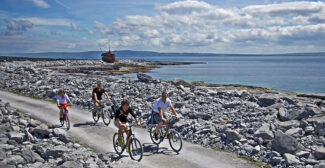Explore the Pacific Northwest’s Watery Underworld
Low tide along the Washington and Oregon coast reveals an uncommon ecosystem that underwater critters call home. We’ve roamed the many tide pools across the Northwest, talked to numerous experts and analyzed waves of tidal data to help you plan your next tide-pool trip.
Twice each day wherever surf meets jagged shore, the ocean lifts its frothy curtain, offering a brief window to the underwater world.
It’s an ageless motion wherein the Earth and moon share a sort of dance around the sun, a celestial waltz that tugs at the edges of the sea, leaving saltwater pools that glisten on the rocks and teem with extraordinary life.
But true tide pool aficionados know that low tides are not all created equal. Twice each month, when the moon is in its full and new phases, it lines up with the Earth and sun, enhancing the gravitational attractions that govern the tidal force.
Further, there’s a sweet spot every summer when the elliptical paths of these heavenly orbits all angle in a way to inspire the highest highs and lowest lows of the tidal range, a veritable limbo game between land and water that always reveals something incredible.
Here, we’re bringing the best of both worlds together, showcasing the surest dates and the finest places to explore the most extreme low tides of the year.
Minus Tides: The Best Time to Visit Tide Pools
The best time to visit tide pools is during a “minus tide,” shown as negative measurements in the 2021 tide tables below. A minus tide of -1.7 feet, for example, means the water at low tide is about 1.7 feet (or about 20 inches) below the average sea level. It’s important to remember that even the most reliable tide predictions are still only predictions, and real-time factors like wind, storm surges and changes in barometric pressure can hold the tide back or push it forward.
This data and our tide pool safety and etiquette tips are meant to help plan a safe and enjoyable trip. Always inquire locally for the most up-to-date information. Learn more about tides and currents.

Cobble Beach, Newport, Oregon
Part of Yaquina Head Outstanding Natural Area, the ancient basalt lava flows that make up these splendid pools fan out under the watchful eye of Oregon’s tallest lighthouse. Take the 115 steps down the rugged cliffside (with landings and benches along the way) to explore the briny baths where anemones, urchins and sea stars bask in summer splendor.
Deep low tides offer an unparalleled density of life at the edge of the continent, with rangers on hand to answer questions and point out extra special tidbits that take a trained eye. Eventually, the tide will nudge you back to the beach, where its namesake rock cobbles roll in the waves, writing music millions of years in the making.
Cobble Beach, Yaquina Head, Newport, Oregon
JUNE
| DATE | TIME | FT. |
| June 23 | 5:57 a.m. | -2.0 |
| June 24 | 6:47 a.m. | -2.5 |
| June 25 | 7:35 a.m. | -2.7 |
| June 26 | 8:23 a.m. | -2.5 |
| June 27 | 9:09 a.m. | -2.2 |
JULY
| DATE | TIME | FT. |
| July 22 | 5:45 a.m. | -1.8 |
| July 23 | 6:35 a.m. | -2.1 |
| July 24 | 7:22 a.m. | -2.2 |
| July 25 | 8:05 a.m. | -2.1 |
| July 26 | 8:47 a.m. | -1.7 |
AUGUST
| DATE | TIME | FT. |
| Aug. 20 | 5:33 a.m. | -1.3 |
| Aug. 21 | 6:20 a.m. | -1.5 |
| Aug. 22 | 7:03 a.m. | -1.5 |
| Aug. 23 | 7:43 a.m. | -1.2 |
| Aug. 24 | 8:18 a.m. | -0.8 |

Hug Point State Park, Arch Cape, Oregon
Just five miles south of Cannon Beach, this small stretch of sand beckons with huge allure. Towering Sitka spruce top the sheer cliffs that edge the park, and a short walk leads to a surprising 15-foot seasonal waterfall.
Continue north along the beach, where caves and crevices have been carved out of the burnt-orange sandstone rock face. During the 19th century, horses and stagecoaches used this same route as a highway, “hugging” the tip of the point to avoid the surf as they made their way around the headland. Later, a roadbed was cut into the cape so automobiles could avoid a rising tide.
Today, the barnacle-covered road can still be seen, and the tide pools below it teem with life. Sea stars cling to this special slice of Oregon history, along with mussels, limpets and anemones. If you venture around the point at extreme low tide keep an eye on the ocean and pay attention to the time. Waves return quickly here, and with powerful force.
Hug Point, Arch Cape, Oregon
JUNE
| DATE | TIME | FT. |
| June 23 | 7:15 a.m. | -1.3 |
| June 24 | 8:04 a.m. | -1.6 |
| June 25 | 8:53 a.m. | -1.7 |
| June 26 | 9:41 a.m. | -1.6 |
| June 27 | 10:29 a.m. | -1.4 |
JULY
| DATE | TIME | FT. |
| July 22 | 7:04 a.m. | -1.1 |
| July 23 | 7:53 a.m. | -1.3 |
| July 24 | 8:39 a.m. | -1.3 |
| July 25 | 9:23 a.m. | -1.2 |
| July 26 | 10:05 a.m. | -0.9 |
AUGUST
| DATE | TIME | FT. |
| Aug. 20 | 6:00 a.m. | -0.6 |
| Aug. 21 | 6:51 a.m. | -0.8 |
| Aug. 22 | 7:37 a.m. | -0.9 |
| Aug. 23 | 8:19 a.m. | -0.8 |
| Aug. 24 | 8:58 a.m. | -0.6 |

Tunnel Beach, Oceanside, Oregon
A magnificent stop along the Three Capes Scenic Loop in Tillamook County, the village of Oceanside offers panoramic views from almost every angle. Its popular sandy beach at the Oceanside Beach State Recreation Site is bounded on the north by Maxwell Point, a formidable finger of land with secrets to keep. Entrepreneurs in the 1920s blasted through the cliff, creating the small corridor that allows access to Tunnel Beach.
Almost 100 years later, walking though this narrow passageway still feels like an adventure worth the risk. The other side hosts a gorgeous beach where you can follow the headland seaward to explore a shallow cave only accessible at extreme low tide. At the north end, rocky outcroppings weave a barnacle-covered labyrinth to pools that beckon with colorful seaweed and creatures as amazing as the landscape.
Tunnel Beach, Oceanside, Oregon
JUNE
| DATE | TIME | FT. |
| June 23 | 6:57 a.m. | -1.5 |
| June 24 | 7:46 a.m. | -1.8 |
| June 25 | 8:35 a.m. | -1.9 |
| June 26 | 9:23 a.m. | -1.8 |
| June 27 | 10:11 a.m. | -1.6 |
JULY
| DATE | TIME | FT. |
| July 22 | 6:46 a.m. | -1.3 |
| July 23 | 7:35 a.m. | -1.5 |
| July 24 | 8:21 a.m. | -1.5 |
| July 25 | 9:05 a.m. | -1.4 |
| July 26 | 9:47 a.m. | -1.1 |
AUGUST
| DATE | TIME | FT. |
| Aug. 20 | 5:42 a.m. | -0.6 |
| Aug. 21 | 6:33 a.m. | -0.9 |
| Aug. 22 | 7:19 a.m. | -1.0 |
| Aug. 23 | 8:01 a.m. | -0.9 |
| Aug. 24 | 8:40 a.m. | -0.7 |

The Needles at Haystack Rock, Cannon Beach, Oregon
Stepping into this marine garden on Oregon’s North Coast feels like taking a leisurely stroll on another planet. Once joined to the coastline, ages of erosion have worn down layers of basalt, leaving craggy sea stacks and rock stumps, each one full of enough nooks to host a wild array of sea life.
Extremely low tides can offer rare glimpses into typically hidden pools and the backsides of these famous rocks, where orange and burgundy sea stars cling in constellations, anemones bloom like summer dahlias, and the sun glints off the prickly spines of purple sea urchins. Seek out a red-coated Haystack Rock Awareness Program steward to help you find the more elusive nudibranch — a captivating sea slug whose colors astound — or a burrowing olive snail with a surprising shell.
Beach wheelchairs are now available to borrow, making the treasures of this unique spot even more accessible (find them at Bahama Boards on Hemlock Street; call (503) 436-4317 to reserve).
Needles at Haystack Rock, Cannon Beach, Oregon
JUNE
| DATE | TIME | FT. |
| June 23 | 6:13 a.m. | -1.4 |
| June 24 | 7:06 a.m. | -1.7 |
| June 25 | 7:56 a.m. | -1.8 |
| June 26 | 8:44 a.m. | -1.7 |
| June 27 | 9:30 a.m. | -1.5 |
JULY
| DATE | TIME | FT. |
| July 22 | 6:03 a.m. | -1.4 |
| July 23 | 6:54 a.m. | -1.7 |
| July 24 | 7:42 a.m. | -1.7 |
| July 25 | 8:26 a.m. | -1.6 |
| July 26 | 8:44 a.m. | -1.3 |
AUGUST
| DATE | TIME | FT. |
| Aug. 20 | 5:50 a.m. | -1.2 |
| Aug. 21 | 6:38 a.m. | -1.4 |
| Aug. 22 | 7:20 a.m. | -1.4 |
| Aug. 23 | 7:59 a.m. | -1.2 |
| Aug. 24 | 8:35 a.m. | -0.8 |

Beard’s Hollow, Cape Disappointment, Washington
Down at the south end of Washington’s aptly named Long Beach Peninsula, this secret gem is a low-tide delight. Giant mounds of basalt (known locally as the “Fishing Rocks,”) seem to erupt from the sand, their walls a patchwork of anemones, barnacles and mussels, and sea caves have been sculpted out of the 200-foot-tall precipice. Sandy pools around the rocks are home to crabs and sometimes sculpin, and at extremely low tides, when the far-west side of the largest rock is exposed, purple, orange and yellow sea stars add magnificent color.
Access this spot in one of two ways: From the parking lot at Beard’s Hollow (part of Cape Disappointment State Park; Discover Pass required), follow the paved trail west. A sandy dune path converges at the first major turn, leading directly to the beach, where the rocks are immediately visible. Alternatively, this part of the beach is open to vehicles and can be reached by heading south from the Seaview beach approach. All regular rules of the road apply, and four-wheel drive vehicles are strongly advised.
Beard’s Hollow, Cape Disappointment, Washington
JUNE
| DATE | TIME | FT. |
| June 23 | 6:13 a.m. | -1.4 |
| June 24 | 7:06 a.m. | -1.7 |
| June 25 | 7:56 a.m. | -1.8 |
| June 26 | 8:44 a.m. | -1.7 |
| June 27 | 9:30 a.m. | -1.5 |
JULY
| DATE | TIME | FT. |
| July 22 | 6:03 a.m. | -1.4 |
| July 23 | 6:54 a.m. | -1.7 |
| July 24 | 7:42 a.m. | -1.7 |
| July 25 | 8:26 a.m. | -1.6 |
| July 26 | 9:06 a.m. | -1.3 |
AUGUST
| DATE | TIME | FT. |
| Aug. 20 | 5:50 a.m. | -1.2 |
| Aug. 21 | 6:38 a.m. | -1.4 |
| Aug. 22 | 7:20 a.m. | -1.4 |
| Aug. 23 | 7:59 a.m. | -1.2 |
| Aug. 24 | 8:35 a.m. | -0.8 |

Second Beach, La Push, Washington
The wild, rugged coastline of Washington’s western Olympic Peninsula doesn’t yield its charms easily — you have to be willing to work for them.
This dramatic beach in the ancestral homeland of the Quileute People is now part of Olympic National Park, and the 1.4-mile round-trip hike to experience it is a small investment with big returns. A moss-lined trail switchbacks lightly through a classic coastal forest before dropping onto a sandy beach with stunning views. Head north toward the Crying Lady, a rock island approachable during minus tides, where you can see the stark lines between tidal zones like writing on a wall.
“The diversity within the pools is amazing,” said Park Supervisory Ranger Janis Burger. “There could be a thousand species in just a square meter of space, most of them in vibrant colors and shapes we can’t conceive of.”
She reminds visitors to be especially sensitive to this ecosystem’s vulnerabilities.
“These creatures are amazingly adapted to a harsh environment — from storm surges to pounding waves to being flooded for half the day and dry the other — but they’re not adapted to being stepped on,” she said. “Be careful, and remember that you’re walking on their homes.”
Second Beach, La Push, Washington
JUNE
| DATE | TIME | FT. |
| June 23 | 6:18 a.m. | -2.1 |
| June 24 | 7:08 a.m. | -2.6 |
| June 25 | 7:56 a.m. | -2.8 |
| June 26 | 8:44 a.m. | -2.7 |
| June 27 | 9:30 a.m. |
JULY
| DATE | TIME | FT. |
| July 22 | 6:06 a.m. | -2.0 |
| July 23 | 6:56 a.m. | -2.3 |
| July 24 | 7:42 a.m. | -2.4 |
| July 25 | 8:26 a.m. | -2.3 |
| July 26 | 9:08 a.m. | -1.9 |
AUGUST
| DATE | TIME | FT. |
| Aug. 20 | 5:33 a.m. | -1.4 |
| Aug. 21 | 6:40 a.m. | -1.6 |
| Aug. 22 | 7:23 a.m. | -1.6 |
| Aug. 23 | 8:03 a.m. | -1.4 |
| Aug. 24 | 8:39 a.m. | -1.0 |

Hole in the Wall, La Push, Washington
Just north of the Quillayute River, Rialto Beach beckons with harsh, unmatched beauty.
Park at the beach and head north for 1.5 miles, ambling along raw beach terrain that feels like the end of the Earth. You might have to find your way over massive driftwood logs or seek out the high-water passage when you encounter a washout, but journey’s end will leave you satisfied as you pass through an ancient rock threshold carved out by the Pacific, traversable only at the lowest tides.
Timing is everything for this experience. Allow 90 minutes of walking each way, plan for snap changes in weather and be sure to arrive at the Hole well before low tide, leaving time to explore its many tide pools and hike back before the sea’s return.
Hole In The Wall, La Push, Washington
JUNE
| DATE | TIME | FT. |
| June 23 | 6:58 a.m. | -2.4 |
| June 24 | 7:46 a.m. | -3.1 |
| June 25 | 8:34 a.m. | -3.0 |
| June 26 | 9:20 a.m. | -2.5 |
| June 27 | 10:07 a.m. | -1.9 |
JULY
| DATE | TIME | FT. |
| July 22 | 6:47 a.m. | -2.6 |
| July 23 | 7:33 a.m. | -2.7 |
| July 24 | 8:17 a.m. | -2.5 |
| July 25 | 8:58 a.m. | -2.1 |
| July 26 | 9:38 a.m. | -1.8 |
AUGUST
| DATE | TIME | FT. |
| Aug. 21 | 6:33 a.m. | -1.9 |
| Aug. 22 | 7:15 a.m. | -1.8 |
| Aug. 23 | 7:54 a.m. | -1.6 |
| Aug. 24 | 8:29 a.m. | -1.1 |

Salt Creek Recreation Area, Port Angeles, Washington
This spectacular North Olympic Peninsula site on the Strait of Juan de Fuca has saltwater colonies covering Tongue Point in every direction. Cement stairs lead down to the water’s edge and drop visitors directly onto the rocks, where urchins, anemones, sea cucumbers and chitons intermingle in one of the most dynamic ecosystems on Earth.
This is the place to train your eyes on the camouflaged sculpin who blends in with the rocks, or spot a crimson-colored blood star feasting on a sponge. With the tide in your favor, you may even find an octopus passing through sea palms or hiding in the rocks while you skip from pool to pool to glorious pool.
When the tide starts coming back in, you may notice water spurting up from a blowhole in the tidelands east of the stairs, but keep a safe distance and get ready to head up.
Salt Creek Recreational Area, Port Angeles, Washington
JUNE
| DATE | TIME | FT. |
| June 23 | 7:23 a.m. | -2.4 |
| June 24 | 8:08 a.m. | -2.8 |
| June 25 | 8:54 a.m. | -2.9 |
| June 26 | 9:41 a.m. | -2.7 |
| June 27 | 10:29 a.m. | -2.2 |
JULY
| DATE | TIME | FT. |
| July 22 | 7:07 a.m. | -2.3 |
| July 23 | 7:54 a.m. | -2.5 |
| July 24 | 8:41 a.m. | -2.4 |
| July 25 | 9:26 a.m. | -2.0 |
| July 26 | 10:11 a.m. | -1.4 |
AUGUST
| DATE | TIME | FT. |
| Aug. 20 | 6:01 a.m. | -1.4 |
| Aug. 21 | 6:54 a.m. | -1.5 |
| Aug. 22 | 7:42 a.m. | -1.5 |
| Aug. 23 | 8:27 a.m. | -1.2 |
| Aug. 24 | 9:08 a.m. | -0.7 |
–Written by Lynette Rae McAdams, who has been chasing the edges of the Pacific Ocean from Baja California to Southeast Alaska for more than 35 years. Her favorite tide pool inhabitant is the giant green anemone.
This story originally appeared in the May/June 2020 edition of the AAA Washington member magazine, Journey.









